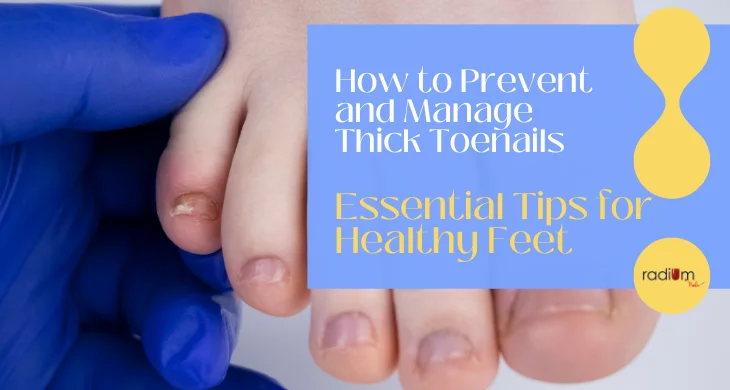Dealing with thick toenails can be both uncomfortable and frustrating, especially when they result from fungal infections, ageing, or underlying medical conditions like nail psoriasis. These conditions not only affect the appearance of your toenails but can also lead to discomfort and pain. However, the good news is that there are several simple yet effective strategies you can incorporate into your foot care routine to prevent and manage thick toenails. By taking proactive steps and prioritizing foot health, you can address the root causes of thick toenails and promote overall foot health and comfort. In this comprehensive guide, we’ll explore various tips and techniques to help you keep your toenails healthy, strong, and free from thickening. Whether you’re dealing with existing thick toenails or looking to prevent them from developing in the future, this guide has got you covered.
Causes of Thick Toenails
Thick toenails can be attributed to a variety of factors, each contributing to the condition in its unique way. Fungal infections, commonly known as onychomycosis, are a prevalent cause of thickened toenails, as the fungus infiltrates the nail bed, causing it to thicken, discolor, and become brittle. Aging also plays a significant role, as natural changes in nail structure and circulation can lead to thickened nails over time.
Trauma or injury to the nail, whether from repetitive pressure or a one-time accident, can damage the nail matrix, resulting in abnormal nail growth and thickening. Nail psoriasis, a chronic skin condition that affects the nails, can cause thickened, pitted, or ridged nails due to inflammation and abnormal cell growth.
Additionally, certain medical conditions like diabetes or peripheral arterial disease can impact nail health and contribute to thickened toenails. Diabetes-related nerve damage and reduced blood flow can compromise the nail bed’s health, leading to thickened, discoloured nails as a result. Understanding these underlying factors is crucial in effectively preventing and managing thick toenails.
Symptoms of Thick Toenails
Recognizing the symptoms of thick toenails is essential for early detection and proper management. One of the most prominent signs is an increase in nail thickness, where the affected nails appear noticeably thicker than usual. This thickening may be uniform or localized to certain areas of the nail.
Changes in nail color or texture are also common indicators of thick toenails. The nails may develop discoloration, ranging from yellowing or brownish hues to white spots or streaks. Additionally, the texture of the nails may become rough, uneven, or brittle, making them prone to cracking or splitting.
Individuals with thick toenails may experience pain or discomfort, especially when wearing shoes or applying pressure to the affected nails. This discomfort may range from mild to severe and can interfere with daily activities or footwear choices.
Furthermore, thick toenails can make it challenging to trim or care for the nails properly. The increased thickness and altered texture may require special tools or techniques for nail maintenance, and individuals may find it difficult to achieve desired nail shapes or lengths.
By being aware of these symptoms, individuals can promptly seek appropriate treatment and care to address thick toenails and prevent associated complications.
Tips to Avoid Thick Toenails
- Prioritize Foot Hygiene: Maintaining optimal foot hygiene is crucial for preventing thick toenails. Ensure to wash your feet daily with soap and water, paying close attention to the spaces between your toes. After washing, thoroughly dry your feet, especially the areas around the toenails, to prevent moisture buildup, which can contribute to fungal infections and thickening. When trimming your toenails, always cut them straight across to reduce the risk of ingrown nails and infections, thus promoting overall nail health.
- Choose Suitable Footwear: The right choice of footwear plays a significant role in preventing toenail thickening. Opt for shoes that provide ample toe room, allowing your toes to move freely without constraint. Look for shoes with proper arch support to distribute pressure evenly and reduce stress on the toenails. Additionally, prioritize breathable materials that allow air circulation, helping to prevent moisture buildup and fungal growth. Avoid tight-fitting or narrow shoes that can cause friction and pressure on the toenails, leading to thickening and discomfort.
- Regular Toenail Monitoring: Consistent monitoring of your toenails is essential for early detection of any changes that may indicate thickening or other abnormalities. Take time to inspect your toenails regularly, looking for signs such as increased thickness, changes in color or texture, or the presence of pain or discomfort. By being vigilant and proactive in monitoring your toenails, you can identify potential issues early on and take necessary steps to address them, preventing further thickening or complications.
By following these tips and adopting a proactive approach to foot care, you can effectively prevent and manage thick toenails, ensuring optimal foot health and comfort. Remember to prioritize regular foot inspections and seek professional advice if you have any concerns or persistent symptoms related to toenail thickening.
Conclusion
Dealing with thick toenails can indeed be challenging, but it’s not a battle you have to face alone. With proactive foot care and timely intervention, you can effectively address this issue. Remember to prioritize good foot hygiene, choose suitable footwear, and monitor your toenails regularly for any changes. By taking these simple yet crucial steps, you can significantly reduce the risk of toenail thickening and ensure the overall health and comfort of your feet. Don’t hesitate to seek professional help if needed, and remember that consistent care and attention are key to keeping your feet happy and healthy.
Frequently Asked Questions
Q: Can thick toenails be caused by fungal infections?
A: Yes, fungal infections are a common cause of thick toenails. Fungal nail infections, also known as onychomycosis, can lead to nail thickening, discoloration, and brittleness.
Q: Are there any home remedies for thick toenails?
A: Some home remedies, such as applying tea tree oil or vinegar soaks, may help manage mild cases of thick toenails caused by fungal infections. However, it’s essential to consult a healthcare professional for proper diagnosis and treatment.
Q: Can thick toenails be a sign of an underlying health condition?
A: Yes, thick toenails can sometimes indicate underlying health issues such as diabetes, peripheral arterial disease, or nail psoriasis. If you notice persistent changes in your toenails, it’s advisable to seek medical advice for evaluation and appropriate management.
Q: Is it safe to trim thick toenails at home?
A: Trimming thick toenails at home can be challenging and may increase the risk of injury or infection, especially if done incorrectly. It’s best to consult a podiatrist or foot specialist for professional nail care and guidance.
Q: How can I prevent toenail fungal infections?
A: To prevent toenail fungal infections, practice good foot hygiene, wear clean and breathable socks, avoid walking barefoot in public places, and promptly treat any cuts or injuries to the feet. Additionally, refrain from sharing nail clippers or other personal items to minimize the risk of fungal spread.

